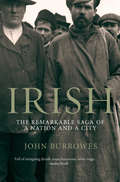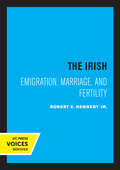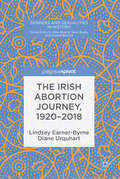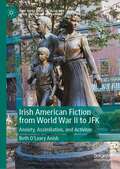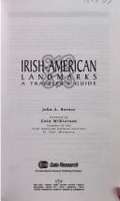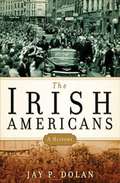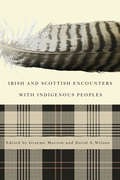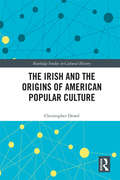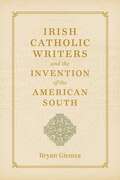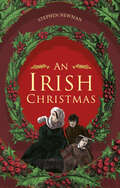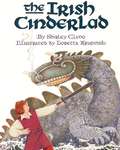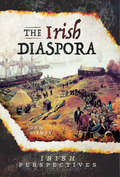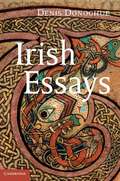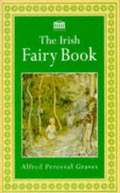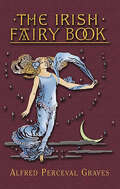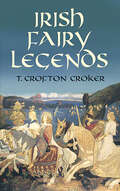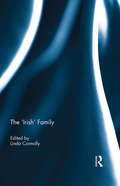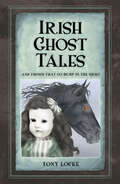- Table View
- List View
Irish: The Remarkable Saga of a Nation and a City
by John BurrowesIrish is the story of the mass migration from Ireland to Glasgow that took place in the wake of the Great Famine of the mid-nineteenth century. It is an epic account of the coming together of a nation and a city. This is the tale of those who escaped a nightmare existence in the poorest and most deprived country in Europe and changed the city of Glasgow forever. Irish brings to life the horrot of those grim days and reveals the unimaginable suffering endured as a result of the Potatoe Blight. It describes in vivid detail the hazards and hardships faced by those fleeing Ireland in search of a better life overseas, including a startling account of one of the most deplorable maritime crimes ever committed, the voyage of the SS Londonderry. The coming of the Irish to Glasgow had a bigger impact on the city than other event. Now, for the first time, the truth about this most significant and stirring episode is vividly unfolded. It tells of the contribution made by Irish labourers in Glasgow to the Industrial Revolution; reveals that the legendary football clubs of Celtic and Rangers may never have existed were it not for the migrant's arrival; and describes the "Partick War", and the occasion of the first-ever Orange Walk.
The Irish: Emigration, Marriage, and Fertility
by Robert E. Kennedy Jr.This title is part of UC Press's Voices Revived program, which commemorates University of California Press’s mission to seek out and cultivate the brightest minds and give them voice, reach, and impact. Drawing on a backlist dating to 1893, Voices Revived makes high-quality, peer-reviewed scholarship accessible once again using print-on-demand technology. This title was originally published in 1973.
The Irish Abortion Journey, 1920–2018 (Genders and Sexualities in History)
by Lindsey Earner-Byrne Diane UrquhartThis book reframes the Irish abortion narrative within the history of women’s reproductive health and explores the similarities and differences that shaped the history of abortion within the two states on the island of Ireland. Since the legalisation of abortion in Britain in 1967, an estimated 200,000 women have travelled from Ireland to England for an abortion. However, this abortion trail is at least a century old and began with women migrating to Britain to flee moral intolerance in Ireland towards unmarried mothers and their offspring. This study highlights how attitudes to unmarried motherhood reflected a broader cultural acceptance that morality should trump concerns regarding maternal health. This rationale bled into social and political responses to birth control and abortion and was underpinned by an acknowledgement that in prioritising morality some women would die.
Irish-American Autobiography: The Divided Hearts of Athletes, Priests, Pilgrims, and More
by James Silas RogersThis lively survey of the ever-changing Irish-American experience contains &“many perceptive, and sometimes surprising, observations&” (The Irish Times). Irish-American Autobiography explores the evolution of Irishness in America through memoirs that describe, define, and redefine what it means to be Irish. From athletes and entertainers to saloon keepers, community activists, and Catholic priests, Irish-Americans of all stripes share their thoughts and perceptions on their ever-evolving ethnic identity. Poet and Irish studies specialist James Silas Rogers begins his evocative analysis with celebrity memoirs by athletes like boxer John L. Sullivan and ballplayer Connie Mack―written when the Irish were eager to put their raffish origins behind them. Later, he traces the many tensions registered by lesser-known Irish-Americans who&’ve told their life stories. South Boston step dancers set themselves against the larger culture, framing their identity as outsiders looking in. Even the classic 1950s sitcom The Honeymooners speaks to the poignant sense of exclusion felt by its creator Jackie Gleason. Rogers also examines the changing role of Catholicism as a cultural touchstone for Irish Americans, and examines the painful diffidence of priest autobiographers. Irish-American Autobiography becomes, in the end, a story of a continued search for connection—documenting an &“ethnic fade&” that never quite happened.
Irish American Fiction from World War II to JFK: Anxiety, Assimilation, and Activism (New Directions in Irish and Irish American Literature)
by Beth O’Leary AnishIrish American Fiction from World War II to JFK addresses the concerns of Irish America in the post-war era by studying its fiction and the authors who brought the communities of their youth to life on the page. With few exceptions, the novels studied here are lesser-known works, with little written about them to date. Mining these tremendous resources for the details of Irish American life, this book looks back to the beginning of the twentieth century, when the authors' immigrant grandparents were central to their communities. It also points forward to the twenty-first century, as the concerns these authors had for the future of Irish America have become a legacy we must grapple with in the present.
Irish-American Landmarks: A Travelers Guide
by John A. BarnesFor Irish-Americans and non-Irish alike, this book is a rich quarry. The author, John Barnes, aims to instruct and to delight and does so very well. He offers all readers colorful snapshots of America's social and political history, which is so intertwined with the story of the Irish in America.
The Irish Americans: A History
by Jay P. Dolan[from inside flaps] "Jay P. Dolan of the University of Notre Dame is one of America's most acclaimed scholars of immigration and ethnic history. In The Irish Americans, he caps his decades of research and writing with a magisterial history of the Irish experience in the United States. Dolan draws on his own groundbreaking work and much other recent scholarship to create a fresh and vivid narrative. He follows the Irish from their first arrival in the American colonies through the bleak days of the potato famine that brought millions of poor immigrants; the decades of ethnic prejudice and nativist discrimination; the rise of Irish political power and the heyday of Tammany politics; and on to the historic moment when John F. Kennedy was elected to the highest office in the land. Dolan evokes the ghastly ships crowded with men and women fleeing the potato blight; the vibrant life of Catholic parishes in cities like New York and Chicago, where the sound of church bells marked the rhythm of each day; and the world of machine politics, where ward bosses often held court in the local saloon. Rich in colorful detail, balanced in judgment, and the most comprehensive work of its kind yet published, The Irish Americans weaves a captivating tapestry of the Irish American experience."
The Irish Americans: A Historical Reader
by James V. MullinKey events and issues in American history through the voices of the Irish Americans who experienced them firsthand.
Irish and Scottish Encounters with Indigenous Peoples: Canada, the United States, New Zealand, and Australia
by Graeme Morton David A. WilsonThe expansion of the British Empire during the eighteenth and nineteenth centuries created the greatest mass migration in human history, in which the Irish and Scots played a central, complex, and controversial role. The essays in this volume explore the diverse encounters Irish and Scottish migrants had with Indigenous peoples in North America and Australasia. The Irish and Scots were among the most active and enthusiastic participants in what one contributor describes as "the greatest single period of land theft, cultural pillage, and casual genocide in world history." At the same time, some settlers attempted to understand Indigenous society rather than destroy it, while others incorporated a romanticized view of Natives into a radical critique of European society, and others still empathized with Natives as fellow victims of imperialism. These essays investigate the extent to which the condition of being Irish and Scottish affected settlers' attitudes to Indigenous peoples, and examine the political, social, religious, cultural, and economic dimensions of their interactions. Presenting a variety of viewpoints, the editors reach the provocative conclusion that the Scottish and Irish origins of settlers were less important in determining attitudes and behaviour than were the specific circumstances in which those settlers found themselves at different times and places in North America, Australia and New Zealand. Contributors include Donald Harman Akenson (Queen's), John Eastlake (College Cork), Marjory Harper (Aberdeen), Andrew Hinson (Toronto), Michele Holmgren (Mount Royal), Kevin Hutchings (Northern British Columbia), Anne Lederman (Royal Conservatory of Music), Patricia A. McCormack (Alberta), Mark G. McGowan (Toronto), Ann McGrath (Australian National), Cian T. McMahon (Nevada), Graeme Morton (Guelph), Michael Newton (Xavier), Pádraig Ó Siadhail (Saint Mary's), Brad Patterson (Victoria University of Wellington), Beverly Soloway (Lakehead), and David A. Wilson (Toronto).
The Irish and the Origins of American Popular Culture (Routledge Studies in Cultural History #57)
by Christopher DowdThis book focuses on the intersection between the assimilation of the Irish into American life and the emergence of an American popular culture, which took place at the same historical moment in the late 19th and early 20th centuries. During this period, the Irish in America underwent a period of radical change. Initially existing as a marginalized, urban-dwelling, immigrant community largely comprised of survivors of the Great Famine and those escaping its aftermath, Irish Americans became an increasingly assimilated group with new social, political, economic, and cultural opportunities open to them. Within just a few generations, Irish-American life transformed so significantly that grandchildren hardly recognized the world in which their grandparents had lived. This pivotal period of transformation for Irish Americans was heavily shaped and influenced by emerging popular culture, and in turn, the Irish-American experience helped shape the foundations of American popular culture in such a way that the effects are still noticeable today. Dowd investigates the primary segments of early American popular culture—circuses, stage shows, professional sports, pulp fiction, celebrity culture, and comic strips—and uncovers the entanglements these segments had with the development of Irish-American identity.
Irish Canadian Conflict and the Struggle for Irish Independence, 1912-1925
by Robert MclaughlinBetween 1912 and 1925, Ireland convulsed with political and revolutionary upheaval in pursuit of self-government. Canadians of Irish descent, both Catholic and Protestant, diligently followed these conflicts, and many became actively involved in the dramatic events overseas. Irish Canadian Conflict and the Struggle for Irish Independence tells the unique story of how Irish Canadians identified with their ancestral homeland during this revolutionary era. Drawing on ethnic weekly newspapers and fraternal society records, Robert McLaughlin finds new interpretations of how Orange Canadian unionists and Irish Canadian nationalists viewed their heritage, their membership in the British Empire, and even Canadian citizenship itself.McLaughlin also provides strong evidence that neither time nor distance diminished Irish Canadians' attachment to their familial homeland or their identification with their respective ethnic communities in Ireland. Irish Canadian Conflict and the Struggle for Irish Independence reconsiders existing contextual frameworks and confronts the challenging questions inherent in understanding this period.
Irish Catholic Writers and the Invention of the American South: Domestic Workers and Their Employers in the Segregated South (Southern Literary Studies)
by Bryan GiemzaIn this comprehensive study, Bryan Giemza retrieves a missing chapter of Irish Catholic heritage by canvassing the literature of American Irish writers from the U.S. South.Beginning with the first Irish American novel, published in Winchester, Virginia, in 1817, Giemza investigates nineteenth-century writers contending with the turbulence of their time -- writers influenced by both American and Irish revolutions, dramatists and propagandists of the Civil War, and memoirists of the Lost Cause. Some familiar names arise in an Irish context, including Joel Chandler Harris and Kate (O'Flaherty) Chopin. Giemza then turns to the works of twentieth-century writers, such as Margaret Mitchell, John Kennedy Toole, and Pat Conroy. For each author, Giemza traces the impact of Catholicism on their ethnic identity and their work. Giemza draws on many never-before-seen documents, including the correspondence of Cormac McCarthy, interviews with members of the Irish community in Flannery O'Connor's native Savannah, Georgia, and Giemza's own correspondence with writers such as Valerie Sayers and Anne Rice. This lively history prompts a new understanding of how the Catholic Irish in the South helped invent a regional myth, an enduring literature, and a national image.
An Irish Christmas
by Stephen NewmanThis book is a compendium of material, in English and Irish, on the festival of Christmas from the manuscripts of the National Folklore Collection recalling how Christmas was celebrated in the nineteenth and early twentieth century in all its regional diversity. The book begins with accounts of the Christmas preparations, before moving through Christmas Eve, with its fasting, feasting and a multitude of superstitions, Christmas Day, with its focus on the home and family, and on to the accounts of the communal celebration of St Stephen's Day with Wren Boys, games and hunting. Moving towards New Year's Day, the book recalls the optimism and fear associated with a transitional time when omens for the coming year were keenly observed, and finally concludes with accounts of the Little Christmas, also known as the Women's Christmas, celebrated on 6 January, and at which point the twelve-day festival comes to a close.
The Irish Cinderlad
by Shirley ClimoBecan, a poor boy belittled by his stepmother and stepsisters, rescues a princess in distress after meeting a magical bull.
The Irish Diaspora: The 1641 Rebellion In Irish History And Memory (Irish Perspectives)
by John GibneyA history of the Irish migrant experience across the globe, as told through real-life stories from throughout the centuries.Ireland is known worldwide as a country that produced emigrants. The existence of the Irish “diaspora” is the subject of this fifth installment of the Irish Perspectives series. From the early Christian era, Irish missionaries traveled across Europe. From the early modern period, Irish soldiers served across the world in various European armies and empires. And in the modern era, Ireland’s position on the edge of the Atlantic made Irish emigrants amongst the most visible migrants in an era of mass migration. Ranging from Europe to Africa to the Americas and Australia, this anthology explores the lives and experiences of Irish educators, missionaries, soldiers, insurgents, from those who simply sought a better life overseas to those with little choice in the matter, all establishing an Irish presence across the globe as they did so.
Irish Essays
by Denis DonoghueDenis Donoghue has been a key figure in Irish studies and an important public intellectual in Ireland, the UK and US throughout his career. These essays represent the best of his writing and operate in conversation with one another. He probes the questions of Irish national and cultural identity that underlie the finest achievements of Irish writing in all genres. Together, the essays form an unusually lively and far-reaching study of three crucial Irish writers - Swift, Yeats and Joyce - together with other voices including Mangan, Beckett, Trevor, McGahern and Doyle. Donoghue's forceful arguments, deep engagement with the critical tradition, buoyant prose and extensive learning are all exemplified in this collection. This book is essential reading for all those interested in Irish literature and culture and its far-reaching effects on the world.
The Irish Fairy Book
by Alfred Perceval GravesIn the introduction, Alfred Graves, father of the poet Robert Graves gives respectful credits to the art in the telling, and care in collecting, of all of the contributors to this book. He selected the tales in this collection for their fidelity to the Irish originals. Dating back to the time of St Patrick, and passed on by word of mouth to the present day, these stories lyrically evoke the spirit of Ireland. One finds tales of a weaver who is full of blarney. He's lucky at disposing of dragons, but his luck runs out when he marries the princess. In another story enchanted pudding makes a wedding couple, the clergy of different churches, and the whole town, go ridiculously mad. In an exotic, lush poem by Alfred Tennyson, a man sails from one strange island to another seeking vengeance for his father's death, and finally learns the secret to steer his course wisely. King Conn The Hundred Slayer, unable to stop the burning of Tara every Samhain, receives help from a stranger. These stories have stirred the hearts and imaginations of the Irish from their very roots when Greeks made their way to Ireland centuries before the time of Christ.
The Irish Fairy Book: Myth And Romance From The Old World (Celtic, Irish Ser.)
by Alfred Perceval Graves George DenhamLeprechauns, fairies, and other mythical figures inhabit this entertaining collection of Irish fairy lore. The rich and representative collection of 43 tales and poems includes "The Stolen Child," a beguiling poem by William Butler Yeats; "The King of the Black Desert," by poet, scholar, and statesman Douglas Hyde; Lady Jane Wilde's "The Horned Women" and "The Demon Cat," as well as works by Joseph Campbell, Jeremiah Curtin, Alfred Lord Tennyson, Patrick Kennedy, and other distinguished writers. A valuable resource for students of Celtic lore, The Irish Fairy Book offers hours of enchanted reading for lovers of folktales.
Irish Fairy Legends (Celtic, Irish Ser.)
by T. Crofton CrokerCome sit by the fire — a world of enchantment awaits you in this treasury of classic Irish stories by folklorist T. Crofton Croker. From 1812 to 1816, he roamed southern Ireland, listening to his countrymen's stories of pixies, leprechauns, and other supernatural creatures. The result is one of the first collections of Irish fairy tales on record — and it's often considered the finest. Told in plain but colorful language with charming illustrations that capture the wonder of these tales, it became an overnight bestseller. An engaging mix of darkness and humor, the thirty-eight stories are filled to the brim with Irish wit and magic. In "The Haunted Cellar," you'll meet one of Ireland's oldest families, with blood as thick as buttermilk and a reputation for hospitality. But what is the secret in Justin Mac Carthy’s wine cellar that forces every butler to quit? In "The Changeling," a new mother finds a just solution when her infant is replaced by a mischievous fairy. "The Legend of Knockfierna" teaches fearless Carroll O'Daly a hard lesson about interfering with the "little people." And that's just a taste of the delights inside. A rich reflection of Celtic culture, Irish Fairy Legends will entertain you and your family for generations.
The 'Irish' Family
by Linda ConnollyWhen situated in the wider European context, ‘the Irish family’ has undergone a process of profound transformation and rapid change in very recent decades. Recent data cites a significant increase in one parent households and a high non-marital birth rate for instance alongside the emergence of cohabitation, divorce, same sex families and reconstituted families. At the same time, the majority of children in Ireland still live in a two-parent family based on marriage and the divorce rate in Ireland is comparatively lower than other European countries. 21st century family life is, in reality, characterised by continuity and change in the Irish context. This book seeks to understand, interpret and theorise family life in Ireland by providing a detailed analysis of historical change, demographic trends, fertility and reproduction, marriage, separation and divorce, sexualities, children and young people, class, gender, motherhood, intergenerational relations, grandparents, ethnicity, globalisation, technology and family practices. A comprehensive analysis of key developments and trends over the course of the twentieth and twenty-first centuries is provided.
Irish Feminist Futures (Transformations)
by Claire BrackenThis book is about the future: Ireland’s future and feminism’s future, approached from a moment that has recently passed. The Celtic Tiger (circa 1995-2008) was a time of extraordinary and radical change, in which Ireland’s economic, demographic, and social structures underwent significant alteration. Conceptions of the future are powerfully prevalent in women’s cultural production in the Tiger era, where it surfaces as a form of temporality that is open to surprise, change, and the unknown. Examining a range of literary and filmic texts, Irish Feminist Futures analyzes how futurity structures representations of the feminine self in women’s cultural practice. Relationally connected and affectively open, these representations of self enable sustained engagements with questions of gender, race, sexuality, and class as they pertain to the material, social, and cultural realities of Celtic Tiger Ireland. This book will appeal to students and scholars of Irish studies, Irish feminist criticism, sociology, cultural studies, literature, women's studies, gender studies, neo-materialist and feminist theories.
Irish Folk History: Tales from the North
by Henry GlassieMade of the words of the people who live today in the beautiful, embattled countryside of Ulster, Irish Folk History is, in essence, the people's own statement of their past. In story, song, and spontaneous essay, these texts, selected from Passing the Time in Ballymenone, tell of the coming of Christianity, of endless war, of the hardships and delights of rural life.During a time of trouble, Henry Glassie came into a community of active story-tellers in County Fermanagh in Northern Ireland, and in this book he sets their voices—their chuckles, whispers, and anger—before us. The words of Hugh Nolan, Michael Boyle, of Peter Flanagan, Hugh Patrick Owens, and their neighbors, echo from the page to present a tale that is at once the story of their tiny community and the story of all of Ireland.
Irish Ghost Tales: And Things that go Bump in the Night
by Tony LockeDo ghosts exist, do supernatural beings walk the land and do creatures linger in the shadows. Are legends of blood-sucking creatures based on some truth found on the edges of reality? Within these pages Tony Locke will take you on a journey through the magical land of Erin. You will explore castles and graveyards, and be introduced to banshees, warlocks, spectres, poltergeists and the Undead. You will read about the spirit of a child that possesses a doll, the vengeful druid who guards a tomb and the ghost of a cannibal woman who enjoyed eating children. Based on the myths and legends of Ireland, these tales have been collected and retold by professional storyteller Tony Locke. So why not pull up a chair and sit awhile? You know you’re never too old for a story.
An Irish Heart: How A Small Immigrant Community Shaped Canada
by Sharon Doyle DriedgerDuring the Great Famine of the 1840s, thousands of impoverished Irish immigrants, escaping from the potato crop failure, fled to Canada on what came to be known as “fever ships.” As the desperate arrivals landed at Quebec City or nearby Grosse Isle, families were often torn apart. Parents died of typhus and children were put up for adoption, while lucky survivors travelled on to other destinations. Many people made their way up the St. Lawrence to Montreal, where 6,000 more died in appalling conditions.Despite these terrible beginnings, a thriving Irish settlement called Griffintown was born and endured in Montreal for over a century. The Irish became known for their skill as navvies, building our canals and bridges, working long hours in factories, raising large, close-knit families. This riveting story captures their strong faith, their dislike of authority, their love of drink, song and a good fight, and their loyalty.Filled with personal recollections drawn from extensive author interviews, An Irish Heart recreates a community and a culture that has a place of distinction in our history. From D’Arcy McGee and Nellie McClung to the Montreal Shamrocks, Brian Mulroney and beyond, Irish Canadians have made their mark.
